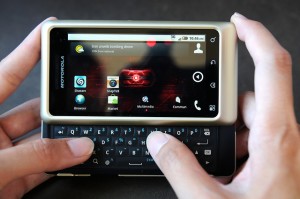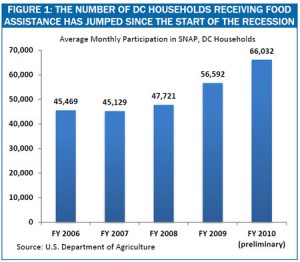There is some good news out today: the national unemployment rate dropped from 9 to 8.6 percent in November. But not all is well, as the unemployment rate remained relatively stable for blacks and Hispanics, while it dropped for whites. Also, the public sector posted government job losses; 5,000 postal workers lost their jobs in November, according to the U.S. Bureau of Labor Statistics. Such public sector losses may be disproportionately affecting African Americans, as they’re overrepresented in the government jobs.
Author Archives: Elahe Izadi
Occupy Movement: Confronting ‘Racial Tension’
Since the early days of the Occupy movement, there have been questions over race and whether protests have been representative of those Americans struggling the most. We’ve written before about efforts in D.C. to boost protest diversity, and the Huffington Post has this interesting dispatch from Detroit, also a mostly-black city, where many early protestors were white.
World AIDS Day: Explaining HIV Infection Rate Disparities
Although HIV infection rates have remained relatively stable for most people, they’ve risen dramatically in recent years for one group: young, black gay men.
Today, as people around the country commemorate World AIDS Day, we thought it appropriate to point our readers to a previous DCentric post explaining why this group is still disproportionately affected by HIV/AIDS. Battling the disease is of particular concern in D.C., where 3 percent of the population has HIV/AIDS.
Three Reasons to Use Phones to Reduce the Digital Divide
By A.C. Valdez
There have been a number of ideas on how to reduce the digital divide, or the disparity in access to technology and the Internet among people of different races and income levels. One strategy: make high-speed Internet cheaper for low-income families, which major cables companies will start doing next summer. But will that tactic actually get more people connected? Maybe not. Here are three reasons why improving mobile broadband access, not cable Internet, might be more effective:
People of color don’t use computers as much as whites do.
But that doesn’t mean, particularly for those who are low-income, they aren’t getting online. African Americans and Hispanics are far outpacing whites in accessing the Internet through mobile devices; nationally, 58 percent of African Americans and 53 percent of Hispanics use mobile broadband, compared to 33 percent of whites, according to the Hispanic Institute.
Those trends hold true locally, too: in a 2010 Public Media Corps survey (which I helped conduct), we found that about 71 percent of blacks and 76 percent of Hispanics in some of D.C.’s poorest wards connect to the Internet using their phones. Meanwhile, about 58 percent of whites in those communities used their phones, while 79 percent used computers.
It’s the money, stupid.
“If you have a low income, you just don’t subscribe,” said John Dunbar, who authored a study examining D.C.’s high-speed adoption rates.
Phones are cheaper than computers, and they’re already in people’s hands. Without government or nonprofit help, pay-as-you-go phone plans may offer convenient payment schemes for people worried about making timely monthly payments on stretched budgets.
Language barriers and dealing with cable companies.
Dealing with a cable company over the phone can be a headache —especially when your first language isn’t English. There are more mobile companies with sales and service locations scattered throughout the city than there are major cable providers. Dunbar found that, even when adjusted for income, Hispanics in the D.C. region are less likely to use high-speed Internet. That may be due to poor marketing to non-English speakers.
Race, Class and Georgetown’s Suit Shops
Georgetown, home to some of the priciest retailers in town, has community activists clamoring over what they feel is their neighborhood’s losing appeal. One resident and developer even wants the city to commit millions of dollars to help spur more development in the neighborhood, a notion that Washington City Paper reporter Lydia DePillis describes as “ridiculous.” At the center of their gripes, she writes, is “the kind of tacky retail” that doesn’t “fit what they think the high-class image of Georgetown should be.”
This post has been updated to reflect a correction made by the Washington City Paper.
Competing For Flat-Screen TVs and Affordable Housing
Hundreds of people anxiously waited in a long line near 14th Street NW in Columbia Heights last week so they could buy heavily discounted flat-screen TVs and tablet computers. Another long line formed in the neighborhood last night, but this time it was full of people waiting to sign up for affordable housing.
Hundreds people waited Tuesday night, through the rain and with some camping overnight, to sign up for newly-renovated Hubbard Place’s waiting list. And according to The Washington Post, competition for the apartments “was intense:”
Security guards and two D.C. police officers tried to keep the line orderly, but shouting matches broke out, and some of those who had waited accused others of cutting in line and not waiting their turn.
“There are a lot of people that need housing, a lot of homeless right now,” said Katherine Felder, a security guard who had been waiting in line since midnight. She lost her apartment this year and has been staying with relatives, along with two granddaughters, ages 3 and 2, who are in her care.
“I don’t have anywhere to stay,” she said from under a black umbrella, shifting her weight to keep warm. “I’m cold, wet and soaked to the bone, soaked from my head to my toes. Cold, cold, cold. Haven’t slept all night.”
As the Post points, out, there’s quite a high demand for affordable housing in the city: about 20,000 people are currently on the city’s waiting list. Although D.C. rents aren’t the highest in the nation, they are out-of-reach for many in the city. A little more than half of District residents don’t make enough money to afford a market rate, two bedroom apartment. Development has caused Columbia Heights in particular to become more expensive, which is one reason behind Latinos increasingly settling in more affordable neighborhoods in the city.
New Duke Ellington Mural Connects D.C. to Musical Past
A new Duke Ellington mural has been added to the city’s landscape, joining the other iconic Ellington mural located on U Street, formerly known as “Black Broadway.” The new mural is painted on the side of the Duke Ellington building at 2121 Ward Place NW, near the site where the jazz legend was born. The building now houses a post office, among other services. The mural is painted by local artist Aniekan Udofia (who, full disclosure, is a friend of mine).
Achievement Gap Wider By Income Than By Race
The academic achievement gap between low income and wealthy students is nearly double the gap in achievement between white and black students, a new study finds.
Standford University professor Sean Reardon compared average standardized test performances of students at the bottom of the income ladder to those at the top, and found the gap in achievement was nearly double the difference between black and white students.
More D.C. Households on Food Stamps
Food stamp usage in D.C. actually went up last year, despite census estimates to the contrary, The District’s Dime reports. According to the U.S. Department of Agriculture, 17 percent more households received food stamps in 2010 than in 2009.
In 2008, the food stamp program was renamed as the Supplemental Nutrition Assistance Program, or SNAP. Check out DCentric’s primer on food assistance programs which delineates who qualifies for what programs and what they provide.
Dream Act Opponents Include Documented Immigrants
A debate rages on in neighboring Maryland over the Dream Act which, if passed, would allow undocumented immigrant students to qualify for in-state college tuition. Some documented immigrants have come out against the measure, although they represent a minority of the state’s immigrants who are mostly Hispanic and come from mixed-legal status families, The Washington Post reports.











